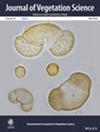Experimental Warming Affects Salt Marsh Litter Decomposition Through Changes in Plant Species Assemblage
Abstract
Questions
Salt marshes are highly productive coastal ecosystems that, like other coastal wetlands, play a key role in climate change mitigation due to their efficiency in sequestering and storing atmospheric carbon (C). This ability is partly explained by the low decomposition rates of organic matter that is buried in their sediments. However, given that decomposition dynamics are temperature-dependent, escalating temperatures potentially threaten salt marsh C sequestration capacity. The question addressed in this study is whether increasing temperature affects salt marsh detritus decomposition rates not only directly but also indirectly by affecting plant community composition.
Location
We performed a field manipulative experiment in a Southwestern Atlantic salt marsh in the Mar Chiquita coastal lagoon, Argentina.
Methods
We increased temperature using open-top chambers (OTCs). At the end of a 3-year experiment, we estimated plant species cover at each plot and estimated litter decomposition rates with a litterbag approach using a standardized substrate (i.e., Spartina litter) and a community-based substrate.
Results
Results show that the use of OTCs raised the temperature in warming treatments by 1.05°C on average. After 3 years of experiment, the plant community structure under warming was characterized by increased dominance of Spartina densiflora, which produces a less labile detritus. Warming reduced the decomposition of community-based litter by 50% to levels similar to those of the standardized Spartina litter.
Conclusions
Our results show that warming is likely to have significant consequences on salt marsh plant community structure, increasing the biomass of the dominant species and driving more recalcitrant litter production, which could slow decomposition dynamics. Despite only covering 0.3% of the land surface, salt marshes are important C reservoirs; thus, the contrasting dynamics of warming on salt marsh decomposition should be considered when assessing the broader effects of global change.


 求助内容:
求助内容: 应助结果提醒方式:
应助结果提醒方式:


